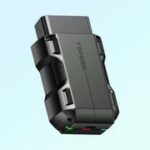OBD2 scanners and programmers have become indispensable tools for modern auto repair shops. These devices provide a gateway into a vehicle’s electronic control unit (ECU), allowing technicians to diagnose issues, program keys, and perform various other functions essential for efficient and accurate vehicle maintenance. This article explores the capabilities and benefits of incorporating an Obd2 Scanner And Programmer into your automotive toolkit.
Understanding OBD2 Scanners and Programmers
An OBD2 scanner, also known as a diagnostic scan tool, connects to the vehicle’s OBD2 port, typically located under the dashboard. It retrieves diagnostic trouble codes (DTCs) stored in the ECU, providing insights into potential malfunctions within the engine, transmission, emissions system, and other critical components. These codes, along with live data streams from various sensors, help pinpoint the root cause of problems, facilitating faster and more effective repairs.
Beyond diagnostics, an OBD2 programmer goes a step further by enabling modification of the ECU’s software. This functionality allows for tasks such as key programming, module coding, and even performance tuning in certain applications. For instance, if a customer loses their car keys, an OBD2 programmer can be used to program a new key fob, eliminating the need for costly replacements from the dealership.
Benefits of Using an OBD2 Scanner and Programmer
Investing in a quality OBD2 scanner and programmer offers numerous advantages for auto repair professionals:
Improved Diagnostic Accuracy: By accessing DTCs and live data, technicians can quickly identify the source of vehicle problems, reducing guesswork and minimizing diagnostic time.
Enhanced Repair Efficiency: Accurate diagnostics lead to faster repairs, increasing shop productivity and customer satisfaction.
Expanded Service Capabilities: With programming capabilities, technicians can offer a wider range of services, including key programming, module coding, and potentially performance tuning, generating additional revenue streams.
Reduced Repair Costs: By enabling precise diagnostics and repairs, these tools can help avoid unnecessary parts replacements and minimize labor costs.
Increased Customer Confidence: Demonstrating the use of advanced diagnostic and programming equipment builds trust and credibility with customers, fostering long-term relationships.
Choosing the Right OBD2 Scanner and Programmer
Selecting the appropriate OBD2 scanner and programmer depends on various factors, including budget, required functionalities, and vehicle compatibility. Entry-level scanners provide basic DTC reading and clearing capabilities, while more advanced models offer features such as live data streaming, bi-directional control, and specialized functions for specific vehicle makes and models.
When considering a programmer, ensure compatibility with the intended vehicle types and programming tasks. Some programmers are designed for specific brands or models, while others offer broader coverage. Researching and understanding the specific needs of your shop and the vehicles you service will guide you towards the optimal choice.
Conclusion
In the rapidly evolving automotive landscape, staying ahead of the curve with the right tools is crucial for success. An OBD2 scanner and programmer empowers auto repair professionals with the capabilities needed to efficiently diagnose, repair, and maintain modern vehicles. Investing in these essential tools enhances diagnostic accuracy, improves repair efficiency, expands service offerings, and ultimately contributes to a more profitable and reputable auto repair business. Consider your shop’s specific needs and explore the wide range of available options to find the perfect OBD2 scanner and programmer to elevate your service capabilities.
